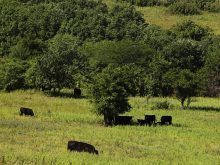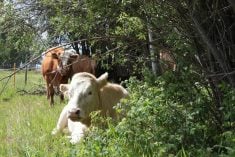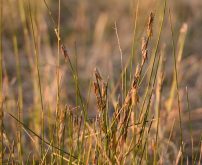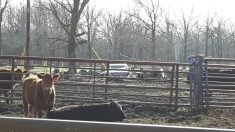It can be a challenge to weigh the benefits and risks of running species such as beef cattle, sheep, bison and horses together on the same pastures, especially if feed is short. The pros and cons can be difficult for you and your veterinarian to address. While usually it is not a problem, there can be positive or negative consequences. Veterinarians can help by comparing the risks of disease and whether there could be transmission between species.
There are some absolute no-no’s. Running sheep with bison, for example, isn’t recommended. There is a huge risk of transmitting malignant catarrhal fever from sheep to bison. Over time, exposure translates into a high risk of death.
Read Also

Gentle treatments for pain in the neck
Heading toward year-end, people unknowingly tense up against the cold and busyness, causing neck pain that can often be treated with appropriate support and gentle mobility, athletic therapist Kathlyn Hossack says.
One common problem can be stress if one species begins harassing or running the other. Certain horses can always chase cattle. In other cases the two species adjust well and can pasture side by side.
What about disease spread?
Diseases such as Johne’s can be transmitted, especially between bison, cattle, sheep or goats. Other diseases that come to mind include clostridial disease, salmonella, bacterial pneumonia or leptospirosis. Check the labels of specific vaccines to determine which species are covered. In some cases a veterinarian might consider the use of vaccines on species not indicated on the label if the need warrants. We call this ‘extra label usage.’ It commonly happens for bison and goat producers because nothing is on the label for those species. In some cases the subtypes of bacteria that commonly affect one species may not commonly affect another, but in medicine there are always exceptions to these rules.
Similarly, when dealing with wildlife mixing with cattle, most times the bacterial or viral diseases are not shared. However, we have just heard of a mycoplasma pneumonia carried by domestic sheep that can be very pathogenic to wild bighorn sheep. As ranges of wildlife and domestic animals cross over and with increasing population density, transmission can occur. Grazing patterns of each species generally stick together, helping to keep disease transmission down.
Fortunately, parasite transmission is almost exclusively species specific. If there is a big differences between species, they will each have their species of disease nematodes. Cattle don’t share common parasite species with sheep or horses, for example, but they may infect bison. Sheep and goats will share parasites such as internal worms and protozoa such as coccidia with donkeys and horses. So for reasons of parasite transmission and also for interbreeding, cattle and bison should not run together and neither should horses and donkeys. It is interesting to note that if they are all on the same pasture, bison and donkeys get more of a parasite load than cattle.
I have seen sheep and goats run together for control of pasture and different weed species, though one must remember that the disease prevalence and pasture control are a sum of the two different species.
With a sole-species-grazing concept, there is a reduced risk of cross contamination, but there are exceptions. I know of a project where intensively grazing sheep on thick leafy spurge helped control a difficult weed. The sheep get the nutritional benefit and the weed gets controlled. Also, we know places where sheep are good at grazing in and around solar panels. They are much more effective than goats, as goats will eat pretty much anything, including electrical cords and wiring. The sheep are fussy grazers and will leave all that alone. Goats are also used to graze grass and greenery, cutting down fire hazards and helping with weed control.
When it comes to commingling of wildlife and domestic cattle, moderation is the key. Problems arise if there are too many different animals close together. Many a purebred breeder has had a bull fail their tests for leptospirosis, so semen cannot be collected and exported. Often the infection is traced back to free-roaming deer and elk who transmit the disease through their urine.
EHD (epizootic hemorrhagic diarrhea) is another rare disease of deer, which in deer causes diarrhea and may show up as a positive blood test, nullifying bull semen for export. It also can cause symptoms in cattle that are pretty similar to hoof and mouth disease, which could be very alarming.
If there you need to pasture or house different species together, please run it by your veterinarian first so you can mitigate any dangers and take the necessary precautions. That includes if spreading livestock manure or human sewage on pasture land. It is important to be aware of the risk of transmission of bacteria, parasites fungal diseases and viral organisms.















